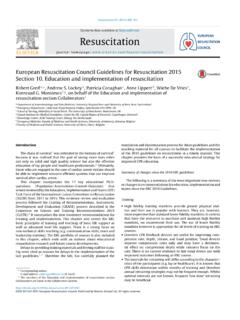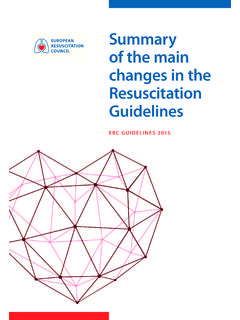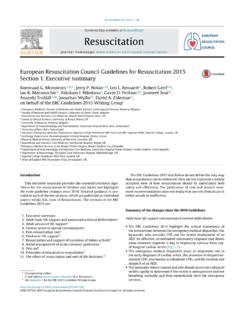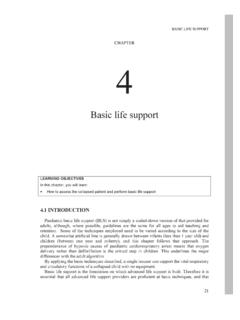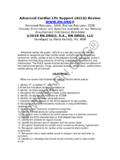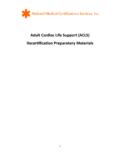Transcription of Contents lists available at ScienceDirect Resuscitation
1 Resuscitation 95 (2015) 81 99 Contents lists available at ScienceDirectResuscitationjou rn al hom ep age : w Resuscitation Council Guidelines for Resuscitation 2015 Section 2. Adult basic life support and automated external defibrillationGavin D. Perkinsa,b, , Anthony J. Handleyc, Rudolph W. Kosterd, Maaret Castr ne,Michael A. Smytha,f, Theresa Olasveengeng, Koenraad G. Monsieursh,i, Violetta Raffayj,Jan-Thorsten Gr snerk, Volker Wenzell, Giuseppe Ristagnom, Jasmeet Soarn, on behalf ofthe Adult basic life support and automated external defibrillation section Collaborators1aWarwick Medical School, University of Warwick, Coventry, UKbCritical Care Unit, Heart of England NHS Foundation Trust, Birmingham, UKcHadstock, Cambridge, UKdDepartment of Cardiology, Academic Medical Center, Amsterdam, The NetherlandseDepartment of Emergency Medicine and Services, Helsinki University Hospital and Helsinki University, FinlandfWest Midlands Ambulance Service NHS Foundation Trust, Dudley.
2 UKgNorwegian National Advisory Unit on Prehospital Emergency Medicine and Department of Anesthesiology, Oslo University Hospital, Oslo, NorwayhFaculty of Medicine and Health Sciences, University of Antwerp, Antwerp, BelgiumiFaculty of Medicine and Health Sciences, University of Ghent, Ghent, BelgiumjMunicipal Institute for Emergency Medicine Novi Sad, Novi Sad, SerbiakDepartment of Anaesthesia and Intensive Care Medicine, University Medical Center Schleswig-Holstein, Kiel, GermanylDepartment of Anesthesiology and Critical Care Medicine, Medical University of Innsbruck, Innsbruck, AustriamDepartment of Cardiovascular Research, IRCCS-Istituto di Ricerche Farmacologiche Mario Negri , Milan, ItalynAnaesthesia and Intensive Care Medicine, Southmead Hospital, Bristol, UKIntroductionThis chapter contains guidance on the techniques used dur-ing the initial Resuscitation of an adult cardiac arrest victim.
3 Thisincludes basic life support (BLS: airway, breathing and circula-tion support without the use of equipment other than a protectivedevice) and the use of an automated external defibrillator (AED).Simple techniques used in the management of choking (foreignbody airway obstruction) are also included. Guidelines for the useof manual defibrillators and starting in-hospital Resuscitation arefound in the section Advanced Life Support summaryof the recovery position is included, with further information pro-vided in the First Aid guidelines are based on the ILCOR 2015 Consensus on Sci-ence and Treatment Recommendations (CoSTR) for review focused on 23 key topics leading to 32 treatment rec-ommendations in the domains of early access and cardiac arrestprevention, early, high-quality CPR, and early defibrillation.
4 Forthese ERC guidelines the ILCOR recommendations were supple-mented by focused literature reviews undertaken by Writing Groupmembers in areas not reviewed by ILCOR. The writing group were Corresponding address: ( Perkins).1 The members of the Adult basic life support and automated externaldefibrillation section Collaborators are listed in the Collaborators of the costs and potential confusion created by changingguidance from 2010, and therefore sought to limit changes to thosejudged to be essential and supported by new evidence. Guidelineswere drafted by Writing Group members, then reviewed by thefull writing group and national Resuscitation councils before finalapproval by the ERC of changes since the ERC 2010 guidelinesGuidelines 2015 highlights the critical importance of the inter-actions between the emergency medical dispatcher, the bystanderwho provides CPR and the timely deployment of an auto-mated external defibrillator.
5 An effective, co-ordinated communityresponse that draws these elements together is key to improvingsurvival from out-of-hospital cardiac arrest (Fig. ).The emergency medical dispatcher plays an important role inthe early diagnosis of cardiac arrest, the provision of dispatcher-assisted CPR (also known as telephone CPR), and the location anddispatch of an automated external defibrillator. The sooner theemergency services are called, the earlier appropriate treatmentcan be initiated and knowledge, skills and confidence of bystanders will varyaccording to the circumstances, of the arrest, level of training andprior ERC recommends that the bystander who is trained and ableshould assess the collapsed victim rapidly to determine if the 2015 European Resuscitation Council.
6 Published by Elsevier Ireland Ltd. All rights Perkins et al. / Resuscitation 95 (2015) 81 99 COMMUNITY RESPONSESAVES LIVES112 Fig. The interactions between the emergency medical dispatcher, the bystanderwho provides CPR and the timely use of an automated external defibrillator are thekey ingredients for improving survival from out of hospital cardiac unresponsive and not breathing normally and then immediatelyalert the emergency possible, alert the emergency services without leav-ing the victim who is unresponsive and not breathing normally isin cardiac arrest and requires CPR. Immediately following cardiacarrest blood flow to the brain is reduced to virtually zero, which maycause seizure-like episodes that may be confused with and emergency medical dispatchers should be suspi-cious of cardiac arrest in any patient presenting with seizures andcarefully assess whether the victim is breathing writing group endorses the ILCOR recommendation thatall CPR providers should perform chest compressions for all vic-tims in cardiac arrest.
7 CPR providers trained and able to performrescue breaths should combine chest compressions and rescuebreaths. The addition of rescue breaths may provide additional ben-efit for children, for those who sustain an asphyxial cardiac arrest,or where the emergency medical service (EMS) response inter-val is prolonged. Our confidence in the equivalence between chestcompression-only and standard CPR is not sufficient to change cur-rent quality cardiopulmonary Resuscitation remains essentialto improving outcomes. The ERC 2015 guideline for chest compres-sion depth is the same as the 2010 guideline. CPR providers shouldensure chest compressions of adequate depth (at least 5 cm but notmore than 6 cm) with a rate of 100 120 compressions per the chest to recoil completely after each compression andminimise interruptions in compressions.
8 When providing rescuebreaths/ventilations spend approximately 1 s inflating the chestwith sufficient volume to ensure the chest rises visibly. The ratio ofchest compressions to ventilations remains 30:2. Do not interruptchest compressions for more than 10 s to provide within 3 5 min of collapse can produce survivalrates as high as 50 70%. Early defibrillation can be achieved throughCPR providers using public access and on-site AEDs. Public accessAED programmes should be actively implemented in public placesthat have a high density of citizens, such as airports, railway sta-tions, bus terminals, sport facilities, shopping malls, offices andcasinos. It is here that cardiac arrests are often witnessed, andtrained CPR providers can be on-scene quickly.
9 Placing AEDs inareas where one cardiac arrest per 5 years can be expected isconsidered cost-effective, and the cost per added life-year is com-parable to other medical interventions. Past experience of thenumber of cardiac arrests in a certain area, as well as the neighbour-hood characteristics, may help guide AED placement. Registrationof public access AEDs allows dispatchers to direct CPR providers toa nearby AED and may help to optimise adult CPR sequence can be used safely in children who areunresponsive and not breathing normally. For CPR providers withadditional training a modified sequence which includes providing 5initial rescue breaths before starting chest compressions and delay-ing going for help in the unlikely situation that the rescuer is aloneis even more suitable for the child and drowning victim.
10 Chest com-pression depths in children should be at least one third of the depthof the chest (for infants that is 4 cm, for children 5 cm).A foreign body causing severe airway obstruction is a medi-cal emergency. It almost always occurs whilst the victim is eatingor drinking and requires prompt treatment. Start by encouragingthe victim to cough. If the victim has severe airway obstruction orbegins to tire, give back blows and, if that fails to relieve the obstruc-tion, abdominal thrusts. If the victim becomes unresponsive, startCPR immediately whilst help is arrestSudden cardiac arrest (SCA) is one of the leading causes ofdeath in Europe. Depending how SCA is defined, about 55 113 per100,000 inhabitants a year or 350,000 700,000 individuals a yearare affected in 6On initial heart-rhythm analysis, about25 50% of SCA victims have ventricular fibrillation (VF), a percent-age that has declined over the last 20 13It is likely that manymore victims have VF or rapid ventricular tachycardia (VT) at thetime of collapse, but by the time the first electrocardiogram (ECG)is recorded by emergency medical service personnel their rhythmhas deteriorated to ,15 When the rhythm is recorded soonafter collapse, in particular by an on-site AED, the proportion of vic-tims in VF can be as high as 76%.


